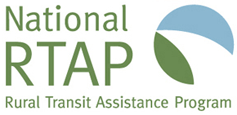Supporting Scheduling Operations
RESOURCES > INFORMATION
From Whiteboards to RideSheet: How Rural Transit Agencies are Supporting Scheduling Operations
If you’ve ever run or supported a small demand-responsive transportation (DRT) service—especially in rural or small urban areas—you know the trip-scheduling drill: clipboards, whiteboards, spreadsheets, sticky notes, and more than a few “Did you write that down?” moments.
For a long time, that patchwork system worked well enough. However, as services grow, riders' needs evolve, and reporting requirements expand, it becomes increasingly challenging to keep everything organized.
That’s where National RTAP’s RideSheet comes in. RideSheet is a tool designed to help small DRT services (with 10 vehicles or fewer) transition from paper-based scheduling to a basic technology platform. RideSheet helps agencies manage rides, riders, drivers, and reports in one centralized place, moving beyond "patchwork" pen-and-paper systems. Built on the Google Workspace platform, RideSheet supports reporting for grants or oversight, making data accessible, actionable, and shareable. By introducing easy-to-apply data workflows, RideSheet helps small transportation providers deliver more efficient transit service. The goal is to enable growth for these agencies, providing them with a foundational tool for data management and a way to integrate technology into their workflows, even preparing them to "graduate" to larger systems if they grow beyond RideSheet's scope.
The Demand-Responsive Transportation (DRT) Data Specifications Working Group, a program of the National Rural Transit Assistance Program (National RTAP) focused on DRT technology and data specification solutions, met in June 2025 to discuss the RideSheet scheduling platform. Kevin Chambers provided an overview of RideSheet, followed by Michael Wilson, who discussed the three-phased RideSheet implementation plan in Kansas rural counties. The meeting concluded with a discussion led by Janet Geissler, of the Michigan State DOT, who offered insights on how State DOTs can support the technology needs of small agencies.
- Kevin Chambers, Principal, Full Path
- Michael Wilson, Director of Mobility Management. Flint Hills Coordinated Transit District (CTD #4)
- Janet Geissler, Mobility Innovations Specialist at Michigan Department of Transportation
- Al Benedict, Technology Tools Lead, National RTAP Moderated the meeting
Following are insights from the working group meeting.
RideSheet Overview
RideSheet is a tool for operating and reporting on small demand-response transportation services. It uses a spreadsheet-based platform built on Google Cloud Infrastructure. Because it is in the cloud, users can benefit from automatic backups and version tracking, as well as collaborate within and across organizations. RideSheet also meets Health Insurance Portability and Accountability Act (HIPAA) security regulations. The spreadsheet itself offers a common platform, as many people are familiar with using them, helping to support its adoption and overcome reluctance toward adopting an entirely new technical application.
RideSheet tracks customers, trips, runs, and more, generating manifests and reports that include common National Transit Database (NTD) data fields. It is also customizable to handle splitting trips between multiple funding sources. RideSheet is not an automated scheduling platform and, as such, is intended for agencies operating 10 vehicles or fewer. Technical details on RideSheet and information on the recent v1 release are available on
Github. Additional resources and a RideSheet user guide are available via
National RTAP.
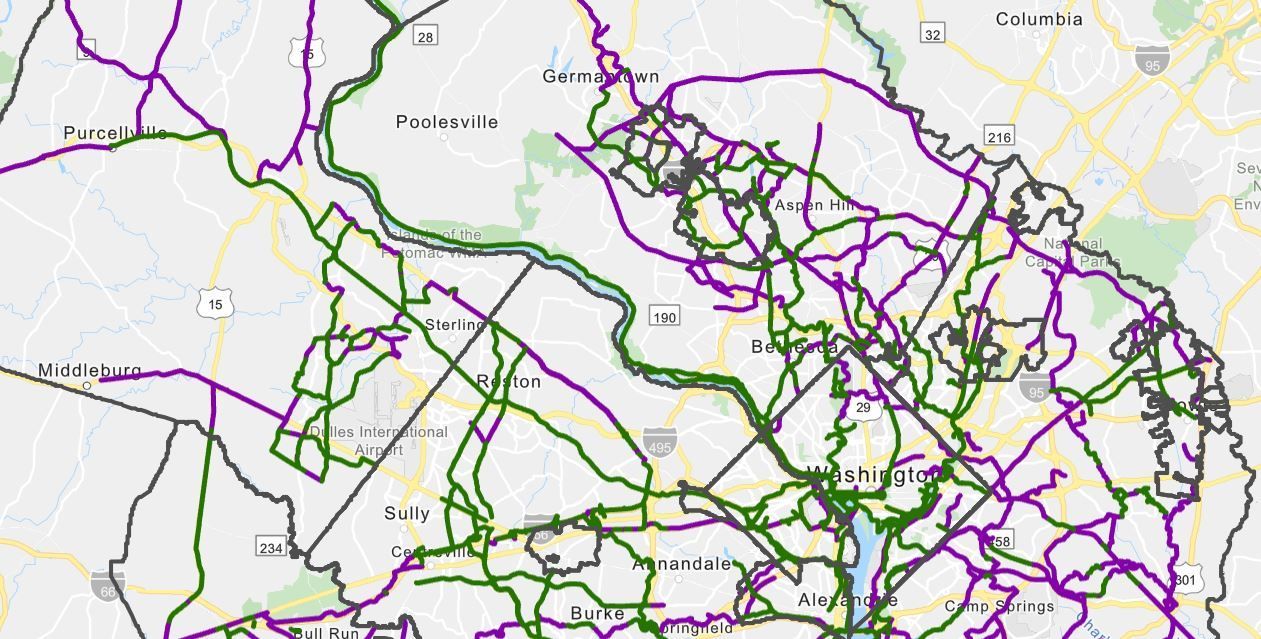
National Capital Trail Network
The greater Washington, DC region is renowned for the quality and extent of its shared-use paths and several notable long-distance bicycle routes that pass through the region. Michael J. Farrell, Senior Transportation Planner for the Metropolitan Washington Council of Governments (MWCOG) in Washington, DC, spearheads a unique shared-use path project that spans across Washington, DC, Maryland, and Virginia.
National Capital Trail Network

National Capital Trail Network
The greater Washington, DC region is renowned for the quality and extent of its shared-use paths and several notable long-distance bicycle routes that pass through the region. Michael J. Farrell, Senior Transportation Planner for the Metropolitan Washington Council of Governments (MWCOG) in Washington, DC, spearheads a unique shared-use path project that spans across Washington, DC, Maryland, and Virginia. The groundwork for the Bicycle and Pedestrian Plan for the National Capital Region began about twenty years ago through the work of the National Capital Region Transportation Planning Board (TPB).
The groundwork for the Bicycle and Pedestrian Plan for the National Capital Region began about twenty years ago through the work of the National Capital Region Transportation Planning Board (TPB). The Bicycle and Pedestrian Subcommittee of the TPB Technical Committee advises the TPB and its Technical Committee and other committees on bicycle and pedestrian considerations in overall regional transportation planning. It meets six times per year and each agency involved sends their bicycle and pedestrian planners. While the TPB is collaborative, the project works so well because the various agencies involved have different needs and roles and can customize their plans based on those; for example, setting speed limits for their area’s shared-use paths. Each jurisdiction has different challenges, and each can plan at its own speed.
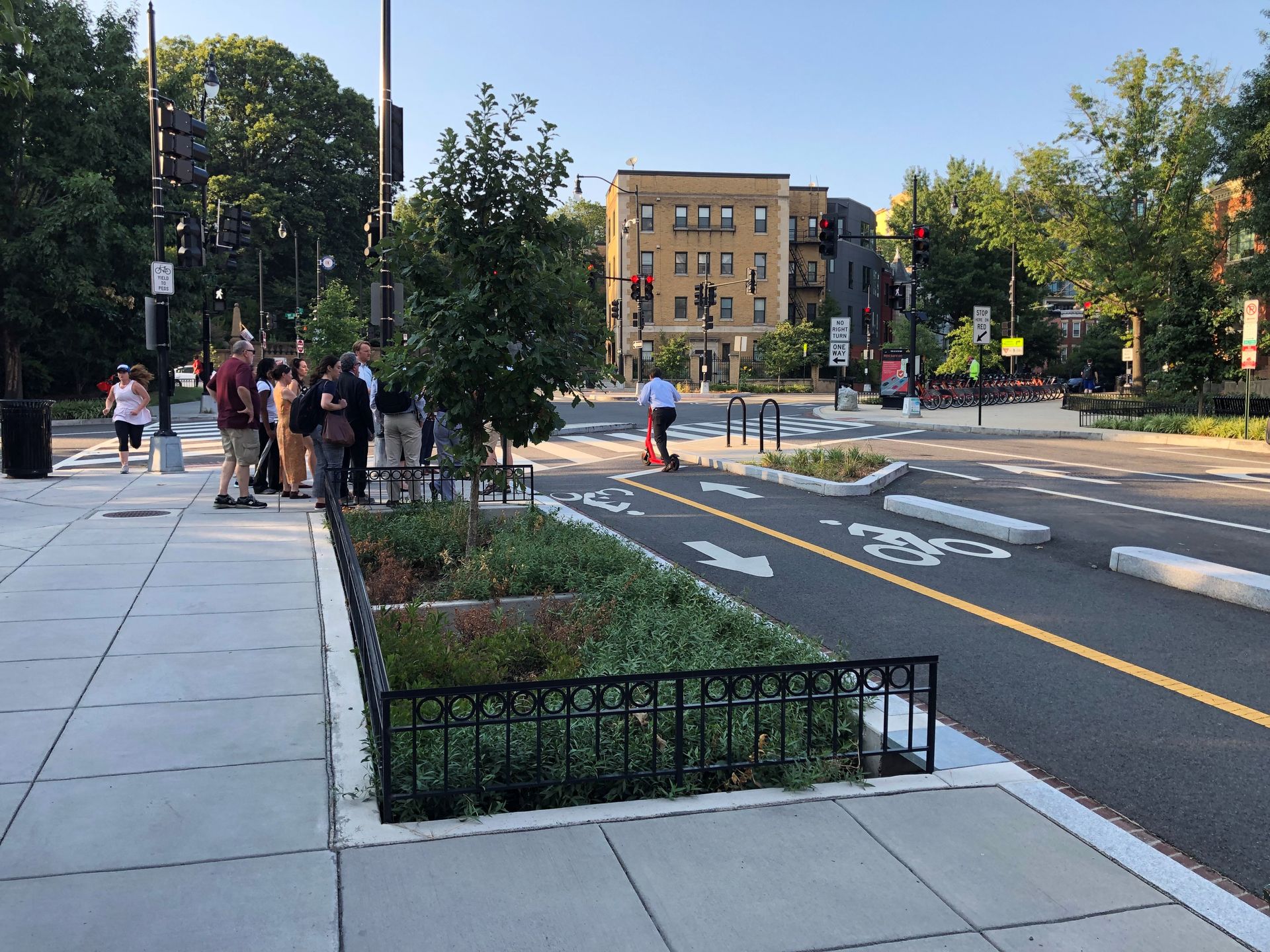
Met Branch
TPB members include large agencies like the National Park Service (NPS) and the Washington Metropolitan Area Transit Authority (WMATA), as well as small, rural transit agencies in the region. The TPB convenes an annual shared micromobility workshop for all its members and administers working groups where agency representatives report on their progress and share best practices. TPB also provides technical assistance to its agencies and provides grant funding. If agencies want funding, they must produce and report on projects such as shared-use paths or long-distance trails. Since the TPB started planning, the region has built a network of approximately 800 miles of shared-use paths consisting of paved or packed crushed stone surface that are suitable for pedestrians, road bikes, e-bikes, and e-scooters. Walking and bicycling account for 11% of all trips in the region. 92% of bike/walk commuters reported being satisfied with their commutes, the highest of any commuter mode, according to a recent survey.
TPB members include large agencies like the National Park Service (NPS) and the Washington Metropolitan Area Transit Authority (WMATA), as well as small, rural transit agencies in the region. The TPB convenes an annual shared micromobility workshop for all its members and administers working groups where agency representatives report on their progress and share best practices.

Met Branch
TPB also provides technical assistance to its agencies and provides grant funding. If agencies want funding, they must produce and report on projects such as shared-use paths or long-distance trails. Since the TPB started planning, the region has built a network of approximately 800 miles of shared-use paths consisting of paved or packed crushed stone surface that are suitable for pedestrians, road bikes, e-bikes, and e-scooters. Walking and bicycling account for 11% of all trips in the region. 92% of bike/walk commuters reported being satisfied with their commutes, the highest of any commuter mode, according to a recent survey. The regional bike sharing program, Capital Bikeshare, includes about 5,000 bicycles at over 600 stations in seven jurisdictions. The project hopes to have over 1,700 miles of shared-use paths by the year 2045.
Figure 1: Sample RideSheet Screenshot
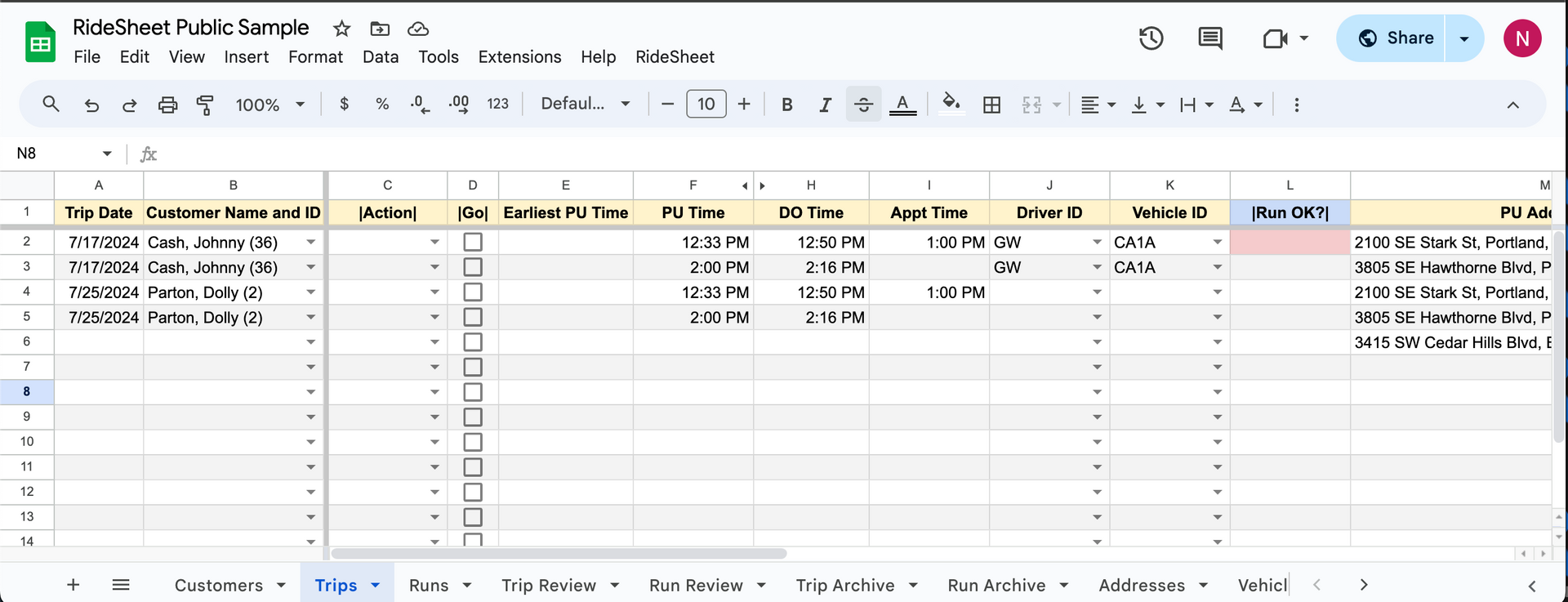
RideSheet Use Cases and Implementation Considerations
RideSheet is currently used in multiple communities across the US:
- Two agencies in Lake County, Oregon
- A volunteer driver program in Provo, Utah
- The Fort Collins, Colorado, region
- Two counties in Kansas, with a third soon to implement
Standard fees for setting up and supporting RideSheet are $6,000 for the first year and $3,000 thereafter. Costs may be lower for multi-agency implementations. Google Workspace starts at $7 per user per month. Additionally, Google offers a program for nonprofits, which begins at $0 per user per month.
A key consideration for implementing RideSheet (or any solution for managing demand-responsive transportation data, for that matter) is dedicating the resources needed to change how work is done. While in the end, RideSheet is likely to offer significant benefits to the agency once it’s fully in place, the road to these benefits is often bumpy. The type of management of organization-wide change that’s called for in this situation is much more likely to succeed when there is at least one person to creatively champion the effort.
DRT Service Coordination Using the TDS
RideSheet is engaged in several pilot programs to implement the
Transactional Data Specification for Demand-Response Transportation (TDS). This allows organizations in the same service area to share trips and refer customers. The TDS functionality works behind the scenes, allowing transit agencies to share trips using the secure Google Workspace platform with neighboring transit agencies. This is a multi-step process, with an agency posting an available trip, another agency accepting that trip, before details on the trip itself are communicated, among other communications that occur throughout a trip's lifespan. In addition to the RideSheet use cases, there are a handful of TDS pilot projects in operation. For more information on the TDS see the
Connecting Community Transportation report.
Kansas Use Case
RideSheet has significantly transformed the operations and impact of DRT services in Clay County, Kansas, moving them from a largely paper-based system to a more efficient, data-driven model. Since implementing RideSheet 2.5 years ago, the agency has expanded its vehicle fleet from 2 to 5 vehicles, and the number of monthly transit trips has grown more than threefold, from around 300 to 1,000. This rapid growth can also present a set of challenges as it can strain staff capacity and budgets. Clay County has since outgrown its previous location in a senior center and now operates from its own building.
In addition to scheduling, Clay County uses RideSheet for its reporting and billing. These efficiencies provided additional savings, as Clay County no longer needed to hire an outside accountant to manage these operations. Clay County has also used the mapping features of RideSheet to strengthen its local partnerships with area hospitals and medical centers. Using the pick-up and drop-off addresses stored in RideSheet, Clay County produced a map and was able to use the visualization to advocate for the purchase of a new van, given the high volume of trips to and from the regional medical center.
Figure 2: Clay County Heat Map of Drop Off Locations Showing Regional Medical Center as a Primary Destination
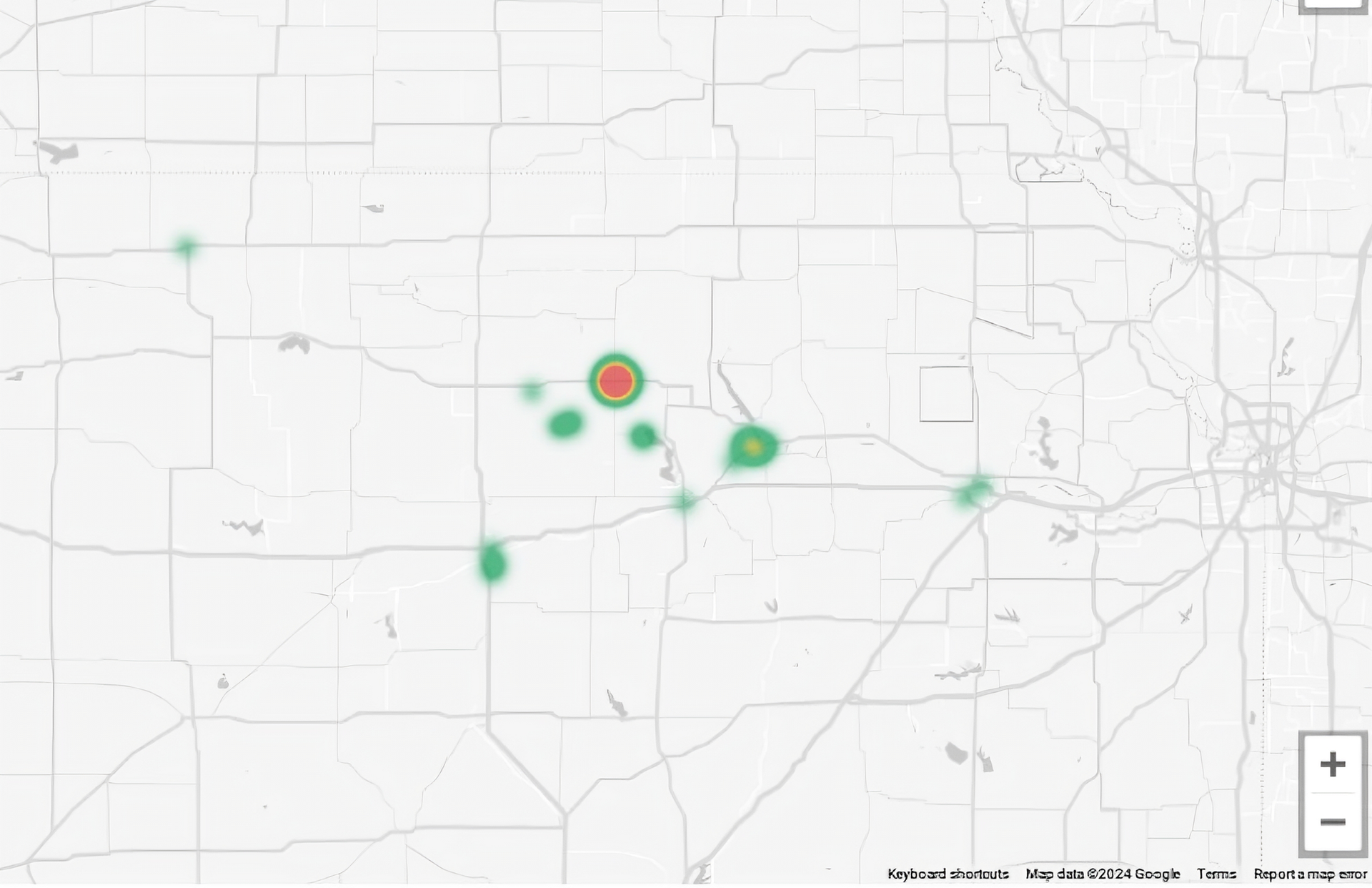
Overcoming Technology Barriers
The shift to RideSheet (and technology solutions in general) does come with some challenges and pain points. In the case of Clay County, there was a reluctance to move from what people had been using for years to a spreadsheet-based scheduling platform on the part of both staff and riders. Although in the case of RideSheet, the scheduling happens largely behind the scenes, and the riders might not even be aware that the agency is using a new scheduling platform.
Clay County could not have moved forward without the support of its Mobility Manager, Michael Wilson. Technology solutions need a local champion who is invested in the program and will work with others to help build support. Wilson has been working with Clay County agency staff to build technical capacity, and one of its biggest staff users is an 86-year-old man whom Wilson referred to as a “power user”. Sometimes it’s not a reluctance to the technology, but rather, it comes down to the time involved in learning a new scheduling platform when agency staff are already busy with their day-to-day work.
Kansas RideSheet Expansion Plan
The broader focus in Kansas is on effectively using technology to support transportation access. The mobility managers are working together to implement RideSheet in two additional counties and test its efficiencies and replicability.

Phase 1 is complete. Clay County is using RideSheet for its scheduling and operations. Phase 2 is underway with Marshall County. The Phase 2 goal is to see how much faster RideSheet can be implemented using a "train the trainer" approach. Phase 3 of the rollout plan is to test if RideSheet can be implemented in another county without direct oversight from Wilson. Supporting agency implementation has been time-consuming for Wilson, who is the Mobility Manager for the Flint Hills region in Kansas, covering seven counties. Using the train-the-trainer approach, Wilson hopes RideSheet will be able to support more agencies throughout rural Kansas.
Kansas RideSheet Agency Profiles
| Population (2023) | Sq.Miles | Scheduling History | Type of Agency | Vehicles in Operation | Avg. Monthly Trips | Status | |
|---|---|---|---|---|---|---|---|
| Phase 1: Clay County | 8,007 | 645 | Paper and pencil dispatching with some spreadsheet reporting | Non-Profit 5311 Transit Agency | 5 vehicles | 850-900 trips currently with a peak of 1,000 | Successful implementation |
| Phase 2: Marshall County | Bill | 900 | Paper and pencil dispatching with spreadsheet reporting | Government 5311 Transit Agency | 2-3 vehicles | N/A | June 2025 goal for full adoption |
| Phase 3: Ottawa County | 5,818 | 720 | Google Calendar | Government 5311 Transit Agency | 2-3 vehicles | N/A | Train the Trainer - Test if another Mobility Manager can guide implementation in another region. |
Source: Kansas Transit RideSheet Pilot Program, Michael Wilson. May 2025
Funding
The Kansas RideSheet implementation was funded under National RTAP. National RTAP had selected three agencies around the country, but only Clay County moved forward. The funding flowed through the Full Path team to set them up with RideSheet and add the features they needed, as well as other supporting work, such as building out documentation and hosting monthly user group meetings. Funding was also used to purchase a computer for Marshall County in order to set up RideSheet and manage the scheduling operations. The process took many months of working with the agencies to identify the three RideSheet pilot programs before moving forward, with Clay County moving forward and subsequently expanding to include Phase 2 and Phase 3.
Clay County General Public Transportation signed a Memorandum of Understanding (MOU) with National RTAP. Michael Wilson is the Kansas Department of Transportation (DOT) designated mobility manager for the region that includes Clay County. He is an employee of Flint Hills Coordinated Transit District (ATA Bus), but there's a contract between the Kansas DOT and ATA Bus that funds his work outside the service boundaries of ATA Bus.
State DOTs Supporting Transit Innovation
State Departments of Transportation (DOTs) can play an important role in fostering technology and mobility solutions for rural transit services. Rural transit agencies often have limited capacity to carry out these solutions.
Understanding the Technology Landscape
State DOT support starts with understanding the current technology landscape. State DOTs can conduct a comprehensive assessment to understand what technology transit agencies are using, what tools they find helpful, and their level of technological literacy. Michigan DOT, for example, developed a
statewide rural transit technology strategic plan with 100% agency participation to identify tech readiness and priorities. The information learned from the strategic plan guides how the department allocates funding and focuses its efforts.
Providing Education and Training
An important role for DOTs is to offer education and training, especially for agencies with limited prior computer experience. These trainings can range from basic computer skills to understanding how to integrate technology into workflows. Looking at the Kansas RideSheet implementation lessons learned, it has shown us that many small agencies need dedicated support and training, not just a one-time sales pitch. Michigan DOT aims to partner with "digital navigation hubs" to provide community-based assistance and training to support small agencies.
Facilitating Technology Adoption through Demonstration Projects
DOTs can accelerate the adoption of transit technology by supporting and conducting demonstration projects. These projects gather lessons learned and showcase how new tools, like RideSheet, can improve operations and reporting for small agencies.
Avoiding the New "Shiny Toy"
State DOTs can help transit agencies focus on desired outcomes and problems that need resolving. This involves guiding agencies to adopt technology scaled to their needs before moving to more complex systems.
Supporting Procurement and Standardization
State DOTs can use joint procurements to acquire technology solutions that are available for small urban and rural agencies across the state. These provide both an economy of scale and create a peer network between transit agencies to share experiences and support one another in technology adoption. Using data standards to communicate information creates another layer of efficiency and replicability, as information is communicated using set protocols that are interoperable across agencies and vendors. There is much written on data interoperability, and for more information, the
Mobility Data Interoperability Principles offers a number of resources to get started.
Budgeting for Technology
State DOTs can work with rural transit agencies to understand the true costs of technology that surpass the initial technology investment or software solution. Marketing, customer outreach, agency and rider education, ongoing maintenance costs, annual licensing fees, and more need to be factored into technology solution expenses.
About National RTAP
National RTAP is managed under a cooperative agreement with the Federal Transit Administration. National RTAP’s overarching mission is to address the training and technical assistance needs of rural and Tribal transit operators across the nation and to support the state RTAP programs. National RTAP hosts a comprehensive set of free technical assistance programs and resources, including training materials, webinars, newsletters, technical briefs, peer resources, research, and innovative technology initiatives.
About the DRT Data Specifications Working Group
The DRT Data Specifications Working Group is co-led by Al Benedict and Jana Lynott. The working group takes a comprehensive approach toward data standards and interoperability, looking at both the technical considerations and addressing the institutional and logistical barriers. Please email the working group co-chairs if you are interested in learning more or participating in the working group meetings.
- Al Benedict, Technology Tools Lead, National RTAP: Albenedict@nationalrtap.org
- Jana Lynott, Transportation Consultant:
jana@janalynott.com
Related Resources
- Report on TDS demonstration projects and addressing barriers to adoption, Connecting Community Transportation
- RideSheet: Rural Transportation Benefits from New Coordination Technology, AARP Public Policy Institute
- Mobility Data Interoperability Principles
- Modernizing Demand-Responsive Transportation for the Age of New Mobility, AARP Public Policy Institute
- Michigan DOT Statewide Technology Plan for Rural Public Transit Agencies (2022)
- National RTAP Introducing RideSheet |
Webinar |
Presentation |
Q&As
This document was prepared by National RTAP with the financial assistance of the U.S. Department of Transportation. The contents do not necessarily represent the opinions or policy of any agency of the U.S. Government, and the U.S. Government assumes no liability for the contents or use thereof. It does not have the force and effect of law and is not meant to bind the public in any way.
Updated July 18, 2025

National RTAP offers one-stop shopping for rural and tribal transit technical assistance products and services. Call, email, or chat with us and if we can’t help with your request, we’ll connect you with someone who can!
" National RTAP offers one-stop shopping for rural and tribal transit technical assistance products and services. Call, email, or chat with us and if we can’t help with your request, we’ll connect you with someone who can! "
Robin Phillips, Executive Director
" You go above and beyond and I wanted to let you know that I appreciate it so much and always enjoy my time with you. The presentations give me so much to bring back to my agency and my subrecipients. "
Amy Rast, Public Transit Coordinator Vermont Agency of Transportation (VTrans)
" I always used the CASE (Copy And Steal Everything) method to develop training materials until I discovered RTAP. They give it to you for free. Use it! "
John Filippone, former National RTAP Review Board Chair
" National RTAP provides an essential service to rural and small transit agencies. The products are provided at no cost and help agencies maximize their resources and ensure that their employees are trained in all aspects of passenger service. "
Dan Harrigan, Former National RTAP Review Board Chair
" We were able to deploy online trip planning for Glasgow Transit in less than
90 days using GTFS Builder. Trip planning information displays in a riders'
native language, which supports gencies in travel training and meeting Title VI
mandates. "
Tyler Graham, Regional Transportation Planner Barren River Area Development District
Slide title
" Having a tool like GTFS Builder is really light years ahead of what it used to be at one time in terms of how fast you can put everything together. Our university students really can't imagine transit without it, so I think it's very important for us in terms of attracting that particular demographic. "
Michael Lachman, Transportation Services Manager HAPCAP - Athens Transit
Slide title
" In the past we used proprietary database software that was very challenging, very murky, and hard to update. GTFS Builder is a great opportunity to make this more user-friendly, more readily updatable and it
would enable us to show how to create a GTFS to more of the staff. "
Jaime McKay, Former Manager of Direct Services Center for Mobility Equity
Slide title
" Collaboration is a buzz word these days in the industry. On behalf of our Tribal segment, I appreciate RTAP for making Tribes a partner in industry opportunities. The organization goes over and beyond reaching partners one would not expect in a busy industry such as public transportation. Thank you for your tireless efforts! "
Franklin Akoneto, Comanche Nation
Slide title
"We are so very thankful for all your transportation training materials. Your resources are as valuable as gold!"
Holly Walton, Transportation Assistant Manager, Curative Connections
A program of the Federal Transit Administration administered by the Neponset Valley TMA
National RTAP is committed to making this website accessible to persons with disabilities. If you need assistance accessing any content on our website or need alternative formats for our materials, please contact us at info@nationalrtap.org or 781-404-5020.
by National RTAP |
